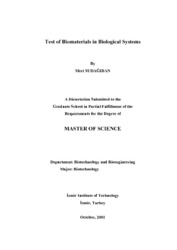Please use this identifier to cite or link to this item:
https://hdl.handle.net/11147/3641| Title: | Test of Biomaterials in Biological Systems | Authors: | Sudağıdan, Mert | Advisors: | Güneş, Hatice | Publisher: | Izmir Institute of Technology | Abstract: | Ceramic, metallic, polymeric and composite materials are generally used as biomaterials in order to improve human health. In addition to desired mechanical properties of biomaterials, biocompatibility is important in the treatment or replacement of body parts. Prior to the introduction of new biomaterials to the market, detailed biological tests are carried out to prevent any undesired side effects in the body. Both in vitro and in vivo tests are applied initially which is followed by the evaluation with clinical trials of the biological safety and performance.The aim of this study was to examine some biomaterials in biological systems.For this purpose, the effects of ceramic, metallic, polymeric and ceramic composite materials with different chemical and surface properties on the viability of peripheral blood mononuclear cells (PBMC) by trypan blue exclusion method, on the proliferation of PBMC by incorporation of bromodeoxyuridine to DNA in the proliferating cells and the activation of PBMC by MTT test were investigated. Furthermore, the effects of biomaterials on the secretion of proinflammatory cytokines (IL-1. and IL-6) from PBMC were examined by using ELISA kits. The alteration of conductivity and pH in different solutions were determined to elucidate dissolution properties of ceramic pellets. In addition, AMES test (Salmonella typhimurium reverse mutation test) for the determination of mutagenic potentials and the agar diffusion method for examination of anti-bacterial effects of biomaterials were applied. Adhesion of pathogenic bacteria to the surface of biomaterials was investigated by staining bacteria and examining under the optical microscope.Except for HA 800 C pellets, all samples showed positive results for biocompatibility compared to the controls without biomaterials. The dissolution of HA 800 °C pellets in the culture medium changed the ionic environment that led to a decrease in the viability, proliferation and activation of PBMC. However, BSA-coated HA 800 °C pellets increased the cell viability with respect to uncoated HA 800 °C pellets. Polished metallic samples and other metallic and polymeric samples showed high percent cell viabilities during 48 hours. After 72 hours, most probably because of released ions and particles to the environment, a decline in the viabilities of PBMC was determined. A negative correlation between increasing extract concentration and the cell viability was observed for all ceramic samples especially after 48 and 72 hours treatments.Cytokine secretion analysis after treatment of PBMC with biomaterials indicated that HA 800 °C, HA-Alumina 1250 °C and HA-Zirconia 1250 °C pellets led to a decrease in IL-1. secretion and BSAcoated HA 800 °C pellets in the presence of LPS. Stainless steel, titanium alloy and cirulene pellets caused low levels of IL-1. secretion. In addition, BSA-coated HA 800 °C pellets increased IL-6 secretion compared to uncoated pellets. In metallic samples, low IL-6 levels were obtained with and without LPS stimulation.Moreover, the proliferation and activation of PBMC in the presence of biomaterials were evaluated. HA 800 °C, HA-Alumina 1250 °C and HA-Zirconia 1250 °C samples had inhibitory effects on the proliferation of PBMC in the presence of Con A. In the activation of PBMC, HA 800 °C and HA 900 °C samples showed the lowest values at all incubation periods. Moreover, other ceramic samples showed lower cell activation than the control cultures after 48 and 72 hours treatments. In addition, the cell activation was observed at 24 hours after treatment with the ceramic extracts at low concentrations.Furthermore, investigation of dissolution properties of ceramic samples indicated that only HA 800 °C pellets led to significant increases in the conductivity of cell culture medium and deionized water. Moreover, a slight increase in the pH levels of solutions was obtained in the presence of HA 800 °C samples, but not in the other samples.Finally, none of the extracts of biomaterials in PBS had mutagenic effect on Salmonella typhimurium TA100 strain when they were compared to the mutagenic material (sodium azide) and the negative controls. In addition, all tested ceramic powders, ceramic pellets, metallic and polymeric materials had no anti-bacterial effects on both gram-negative strains (E. coli, P. aeruginosa, K. pneumonia, Proteus spp.) and gram-positive strains (S. aureus and S. pyogenes). In bacterial adhesion studies, it was found that surface roughness and other surface properties play important roles for attachment, adhesion and formation of biofilm by bacteria on the surface of material.As a result, although the ceramic samples sintered at low temperatures resulted in a decrease in the viability of PBMC, all tested biomaterials showed positive results for in vitro biocompatibility evaluation. | Description: | Thesis (Master)--Izmir Institute of Technology, Biotechnology, Izmir, 2001 Includes bibliographical references (leaves: 79-88) Text in English; Abstract: Turkish and English xvi, 88 leaves |
URI: | http://hdl.handle.net/11147/3641 |
| Appears in Collections: | Master Degree / Yüksek Lisans Tezleri Sürdürülebilir Yeşil Kampüs Koleksiyonu / Sustainable Green Campus Collection |
Files in This Item:
| File | Description | Size | Format | |
|---|---|---|---|---|
| T000021.pdf | MasterThesis | 1.24 MB | Adobe PDF |  View/Open |
CORE Recommender
Items in GCRIS Repository are protected by copyright, with all rights reserved, unless otherwise indicated.